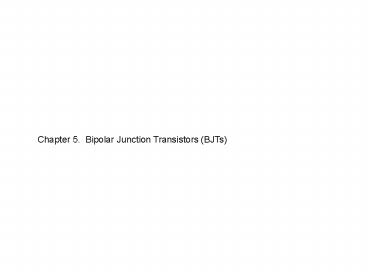Chapter 5' Bipolar Junction Transistors BJTs - PowerPoint PPT Presentation
1 / 73
Title:
Chapter 5' Bipolar Junction Transistors BJTs
Description:
Invented in 1948 at Bell Telephone Laboratories. Dominant ... the same way PMOSFET works ... The transistor performs as a voltage controlled current source ... – PowerPoint PPT presentation
Number of Views:278
Avg rating:3.0/5.0
Title: Chapter 5' Bipolar Junction Transistors BJTs
1
Chapter 5. Bipolar Junction Transistors (BJTs)
2
Bipolar Junction Transistor
- Three terminal device
- Voltage between two terminals to control current
flow in third terminal - Invented in 1948 at Bell Telephone Laboratories
- Dominant until late 1980s
- Reliable under harsh operating conditions
- High frequency applications
- High speed designs
- High power applications
3
- npn transistor
- n-type emitter (E) region, p-type base (B)
region, n-type collector (C) region - Two pn junctions (naming basis for bipolar
junction transistor) - Modes
- Active used for amplifier design
- Cutoff
- Saturation used for logic design
- Reverse active limited operation
4
pnp transistor dual of npn transistor
5
Active Mode of npn Transistor
6
(No Transcript)
7
(No Transcript)
8
Circuit Models for Active Mode npn Transistor
9
Practical Implementation
E and C are not symmetrical.
pnp transistors works dual to npn transistors
much in the same way PMOSFET works dual to
NMOSFET. (In this class, we will concentrate on
npn transistors.)
Skip Sections 5.1.4, 5.1.5, and 5.1.6 (pages 387
392)
10
Circuit Symbols for npn Transistors
Biasing in active mode Directions of current flow
11
(No Transcript)
12
iC vBE Characteristics
Temperature Dependence
13
Common Base Characteristics
In active region, vCB - 0.4 V
Base voltage is fixed at zero.
14
Dependence of iC on Collector Voltage
15
Circuit Models with Output Resistance ro
16
Common Emitter Configuration
17
(No Transcript)
18
Common Emitter Saturation Model
Skip Section 5.2.5 (pages 406 407).
19
Designing Linear Amplifiers (Active Region)
20
Amplifier Gain
21
(No Transcript)
22
Graphical Analysis
23
(No Transcript)
24
To determine iB, iC and vCE, you need to use both
graphs.
25
Quiescent point must be selected to give a
symmetric output swing.
26
(No Transcript)
27
(No Transcript)
28
(No Transcript)
29
(No Transcript)
30
(No Transcript)
31
(No Transcript)
32
Input part
10 V
RB1
RBB
RB1
VBB
10 V
RB2
_
_
VBB
VBB
_
RB2
33
(No Transcript)
34
Biasing BJT
- Determining a quiescent point for linearization
- Active mode operation
- Considerations
- Stable with respect to manufacturing parameters
(e.g., ro, ß) - Desired gains
- Acceptable output swing
35
Biasing with Single Power Supply
- Fix VBE or IB.
- Output directly depends on ß
- Unstable with respect to temperature variation
36
Addition of Degeneration Resistor
37
(No Transcript)
38
Biasing with Two Power Supplies
39
Biasing with Feedback Resistor
40
Biasing with Current Source
41
Small Signal Analysis
- A quiescent point has been determined by biasing.
- Active mode operation
- Forward biasing for base-emitter junction by VBE
- Reverse biasing for collector-base junction by RC
and VCC
42
(No Transcript)
43
(No Transcript)
44
The transistor performs as a voltage controlled
current source with gain gm when input varies by
10 mV or less.
45
(No Transcript)
46
(No Transcript)
47
(No Transcript)
48
Hybrid p Model
- Short circuit voltage sources
- Open circuit current sources
- Short circuit capacitors
49
(No Transcript)
50
T Model
51
(No Transcript)
52
(No Transcript)
53
(No Transcript)
54
Hybrid p Model with Early Effect
55
Structure of Single Stage Amplifier
56
Common Emitter Amplifier
57
(No Transcript)
58
(No Transcript)
59
Common Emitter Amplifier with RE
60
(No Transcript)
61
(No Transcript)
62
Common Base Amplifier
63
(No Transcript)
64
(No Transcript)
65
Common Collector Amplifier
66
(No Transcript)
67
(No Transcript)
68
(No Transcript)
69
Skip Sections 5.8, 5.9 (Pages 485 503)
70
Digital Logic Inverter
Logic 1 vI VCC ? vO VCEsat 0.2 V Logic 0
vI 0 ? vO VCC
Transistor is in saturation mode.
71
vI vO Transfer Function
VCC 5 V RB 10 kO RC 1 kO ß 50
72
(No Transcript)
73
Skip Sections 5.10.2, 5.11 (Pages 505 515)

